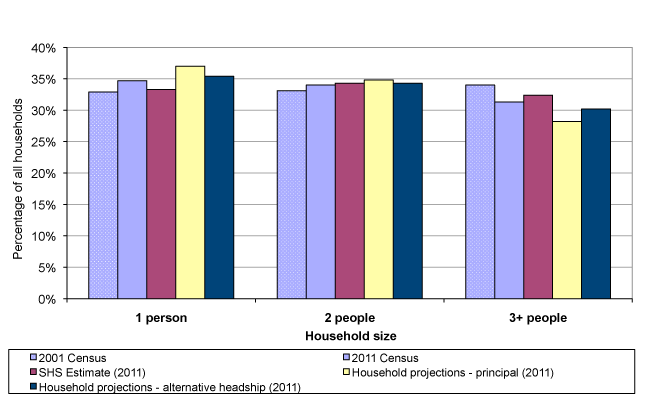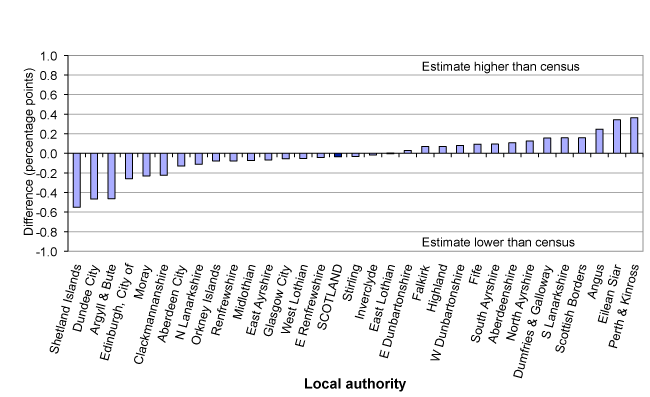
Household projections for Scotland are produced biennially. The household projections are based on the population projections produced by National Records of Scotland (NRS). The number of people living in private households is estimated by taking the population projections for each year and subtracting the people living in communal establishments, such as student halls of residence, care homes or prisons. To estimate the number of households of each type, information on household formation, from the 1991 and 2001 Censuses, is projected forward for each household type, age group and local authority. This information is in the form of headship rates, which are the proportion of the private household population that head a household. These household projections are controlled to the household estimates for the first two projection years.
The latest household projections, available on the National Records of Scotland website, are the 'Household Projections for Scotland, 2010-based'[8]. As these projections are controlled to the 2001-adjusted household estimates for 2010 and 2011 the comparison of total household numbers for Scotland and its local authorities in 2011 is the same as already described for the 2001-adjusted household estimates. Additional information is available from the household projections on the number of households of different sizes and the communal establishment population. This section compares this information to information published in the 2011 Census.
Scotland's Census 2011 Release 1B, available on the Scotland's Census website, contains information about the number of people in each household, from one-person households to households containing five or more people. These household sizes do not completely correspond to the household types used in the household projections, but three common household sizes can be distinguished: one-, two- and three-or-more-person households. These can also be compared to the estimates of households by household type published in 'Estimates of Households and Dwellings in Scotland, 2012' and which are based on Scottish Household Survey (SHS) data. Similarly to the 2001-adjusted household estimates, the SHS data is adjusted to the 2001 Census for the 2001 year, and these adjustments are applied to every subsequent year, to take into account any differences in 2001 that are introduced because the SHS is a voluntary survey.
In the 2010-based household projections, a principal projection was produced, based on the principal population projection, and a principal projection of headship rates. Several alternative projections were also produced, based on alternative assumptions about the population, future household estimates and headship rates. In this section we use the principal projection and the alternative headship rate projection. The latter projection assumes that the headship rates change at half the rate given by the principal projection. This changes the proportion of households in each household type. The changes to the assumptions on population and future household estimates only have minor effects on the proportion of households in each household type, therefore these variant projections are not considered in this section.
Scotland
Previous comparison of the household projections and SHS-based estimates[9] has suggested that the projections may have been over-estimating increases in smaller households (one- and two-person households) and decreases in large households. We believe that this is because since 2001, and particularly since the start of the economic downturn in 2007, fewer people have been choosing to live alone or in small households, particularly amongst young adults, than would have been predicted from the changes between 1991 and 2001. This has resulted in there being fewer smaller households and more large adult households reported in the SHS, for example because young people are choosing to stay with their parents or live in shared households of three or more people.
Figure 7 shows a comparison of the proportions of households in each household type from the three data sources, along with the equivalent data from the 2001 Census. This data confirms that the household projections have been overestimating small households and underestimating large households:
Figure 7: Comparison of different estimates of the distribution of household sizes in Scotland

Local Authorities
Table 4 compares the proportion of households in each household type for the Census estimates and household projections for each local authority in 2011. At local authority level, SHS-based estimates have previously been shown to have a lot of year on year variation so are not considered reliable[10]. In most local authorities, the household projections overestimate the proportions of one- and two-person households and underestimate the proportion of three-person households;
Conclusion
The household projections have been over-projecting the increase in smaller households and the decrease in larger households. This is because the breakdown by household type is calculated using headship rate information from the 1991 and 2001 Censuses that is then projected forward to 2011 and beyond. Since the release of the 2011 Census it has become clear that there was less change in the types of household that people in Scotland live in between 2001 and 2011 than there was between 1991 and 2001. This continues the trend towards smaller changes seen when comparing the 1981 and 1991 Censuses and the 1991 and 2001 Censuses[11]. An alternative headship projection was published alongside the 2010-based principal household projection, which assumes slower changes in headship rates than the principal projection. As a result, the estimates of the proportion of households of each household type in the alternative headship projection are closer to the census estimates than those in the principal projection, both for Scotland and the majority of its local authorities.
NRS have previously investigated incorporating survey data into the projections[12]; however, suitable data is not available at local authority level. It will be important to continue to monitor the data that is available, and investigate new methodologies to incorporate it into the projections, as these results show that the SHS performed better than the household projections in estimating the types of household that people are living in for Scotland as a whole. Incorporating more than two census points into the projection methodology, in order to improve the capture of more long-term changes in trends, will also be considered.
Communal establishments provide managed residential accommodation, where people live in groups that can't be considered households, for example student halls of residence, prisons and care homes. Communal establishment estimates are produced as part of the household projection process. The proportion of the total population that are resident in communal establishments, by age and gender, is used to estimate the population that are resident in private households from the mid-year population estimates and projections.
The latest communal establishment estimates from the household projections are for 2010. These estimates are produced using a range of administrative data sources to update the communal establishment data from the 2001 Census[13]. They have been updated to use data from 2011 wherever possible so that they provide a better basis for comparison to the 2011 Census[14]. The population used to calculate the communal establishment rates using the administrative data is the mid-year population estimate for 2011.
Scotland
In 2011, the administrative data estimated that there were 100,100 communal establishment residents in Scotland, while the 2011 Census estimated that there were 99,000 (a difference of just over one per cent). The number of communal establishment residents has increased from 86,000 in the 2001 Census, an increase of 15.1 per cent between censuses.
Another way of comparing the figures is to compare the proportion of the total population that is resident in a communal establishment (the communal establishment rate). This takes into account the fact that the total population is also increasing. In both the 2011 communal establishment estimates and the 2011 Census, the proportion of the Scottish population that is resident in a communal establishment is 1.9 per cent, up from 1.7 per cent in the 2001 Census.
Local Authorities
Table 5 shows the total population, the number of communal establishment residents and the proportion of the population that is resident in a communal establishment for each local authority. The proportion of the population that was resident in communal establishments was between 0.6 per cent (East Dunbartonshire) and 4.8 per cent (Stirling) in the 2011 Census and 0.5 per cent (East Dunbartonshire) and 4.9 per cent (Stirling) in 2011 estimate.
Figure 8 shows the percentage point difference in the proportion of the population in communal establishments between the 2011 estimates and the 2011 Census. The differences range between 0.4 percentage points lower than the census in Perth & Kinross to 0.6 percentage points higher in the Shetland Islands. Sixteen local authorities had proportions from the census and the estimates within 0.1 percentage point of each other.
Figure 8: Comparison of the proportion of the population in communal establishments between the 2011 communal establishment estimates and the 2011 Census

Conclusion
Overall, the proportion of the total population that is resident in communal establishments in the 2011 estimates is close to the proportion from the 2011 Census, both for Scotland and its local authorities. It is communal establishment rates, rather than the absolute number of communal establishment residents, which are used in the household projections. As with average household size, the estimates of the proportion of the population living in communal establishments will have been affected by differences between the mid-year population estimates and the population estimates from the census.
In the census quality assurance process, NRS also looked at differences between the type of communal establishment the residents were living in; however this data will not be published until a later release of census data (Scotland's Census 2011, Release 2). Additional analysis will be published once further census data is available.